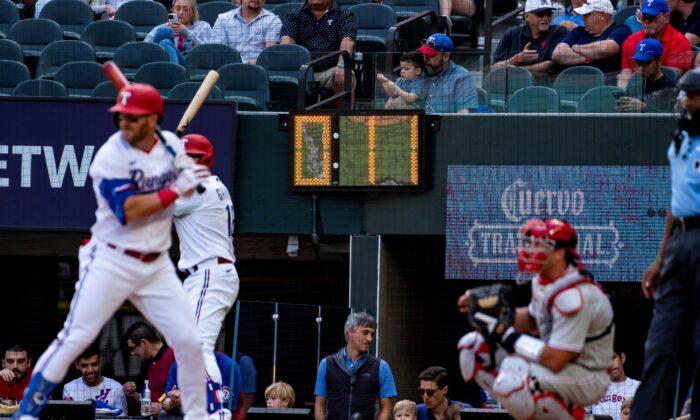NEW YORK—Major League Baseball’s new rules designed to speed pace of play and encourage more action seem to be working through the first 1 1/2 weeks of the season.
Batting average is up 16 points, stolen bases have spiked 30 percent and the average game time is down 31 minutes, on track to be the sport’s lowest since 1984.
Limits on infield shifts, a pitch clock, and larger bases were all implemented on opening day after testing in the minors and a dress rehearsal of sorts during this year’s big league spring training.
“I think they’re good for the game,” Cleveland Guardians manager Terry Francona said. “The goal was to not have them get in the way of how we play. That doesn’t guarantee you’re going to win or lose or play well or bad, but just not get in the way.
“And for the most part, we still have I think a couple pitchers that we’re trying to get a little more comfortable, but I think we’re doing OK.”
The league-wide batting average is .249, a rise from .233 during a comparable period at the start of last season, when cold and wet weather likely contributed to a pallid offensive start. Last year’s average rose to .243 by year’s end, the lowest since 1968.
Right-handed batters have a .253 average, up from .236 at the start of last year, and lefty batting average is .245, up from .228.
Toronto’s Matt Chapman, a right-handed batter, leads the major leagues with a .475 average and Miami’s Luis Arraez, a lefty who won the AL batting crown with Minnesota last year, is second at .471. Paul Goldschmidt and the St. Louis Cardinals lead all teams with a .294 mark.
Angels two-way star Shohei Ohtani is tied with 15 others for the major league lead with two pitch clock violations—both in the same game, one as a hitter and one as a pitcher. The New York Mets have the most of any team with 10.
Two-thirds of pitch clock penalties have been imposed on pitchers. Clock violations were up slightly last week compared to opening weekend but averaged less than one per game.
Average time of nine-inning games dropped to 2 hours, 38 minutes from 3:09 in the first 11 days of last year, when the final average was 3:04. The average was unchanged from the first four days and is on track to the lowest since it was 2:35 in 1984.
“I’ve never experienced anything like this,“ Colorado Rockies first baseman C.J. Cron said. ”So I guess we’re still learning but yeah, it seems like there’s not much downtime, especially on defense. It feels like there’s always action going on.”
There have been 125 pitch clock violations in 141 games, an average of 0.89 per game. The average over the first four days had been 0.82.
Eighty-five violations have been on pitchers (68 percent), 32 on batters (25.6 percent), and four on catchers (3.2 percent). In addition, there were two violations for batter timeouts and two for pitcher disengagements.
“I knew the pitch clock and all that was going to work,“ Atlanta Braves manager Brian Snitker said. ”I’ve experienced it before. And too what I think you’re seeing is a resurrection of the singles. There’s more hits because we’re not flooding the sides of the diamond where a lot of these base hits were outs the last few years.”

There have not been any shift restriction penalties.
Stolen bases have averaged 1.3 per game, up from 1.0, and the success rate increased to 79.6 percent from 74 percent.
“I don’t know,” said Dusty Baker, manager of the World Series champion Houston Astros. “Some years they’re offensive years and some years there’s pitching years. We’ve only played a week. It’s hard to tell.”
MLB, over objections from players, adopted a pitch clock of 15 seconds with no runners on base and 20 seconds with runners. It also required two infielders to be on either side of the second base and all infielders to be within the outer boundary of the infield when the pitcher is on the rubber. Players supported increasing bases to 18-inch squares from 15-by-15, proposed as a safety measure.





